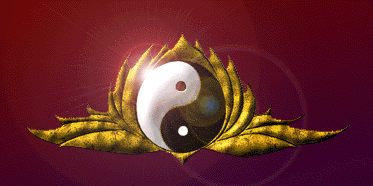
Chen Style
Tai Ji Academy
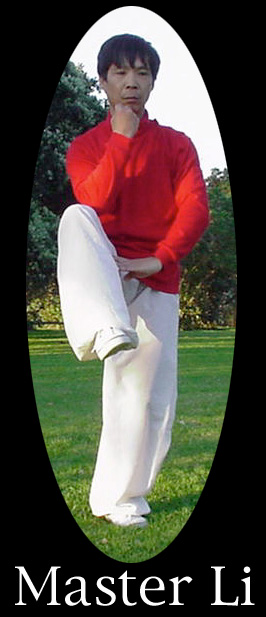
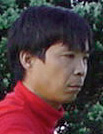 | In
1963, at the age of eight, Mr. Li began studying Chinese Martial Arts in China.
He began by studying Plum Blossom Mantis and Ba Gua. In 1968, at the age of 13,
he became a disciple of Liu Fu Hao and began his study of Chen Style Tai Chi.
Liu Fu Hao's teacher was Chen Zao Kui. Mr. Li studied with Liu Fu Hao until 1979
when he became a direct disciple of Feng Zhi Qiang in Beijing.
| |
| Mr. Li came to New Zealand in 1997. Mr. Li's understanding and ability in Chen Style Tai Chi are unmatched in New Zealand. He understands and exhibits not only a full understanding of the fundamental mechanics and physiological principles of Tai Ji, but also the martial application of each movement in the Chen Style 83 form. | 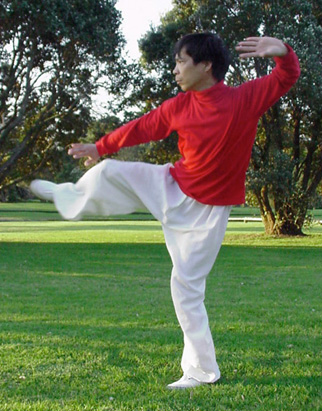 | |
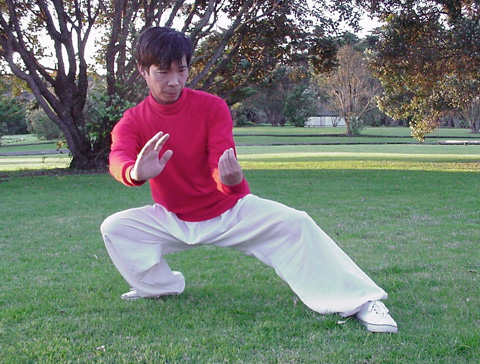 |
Mr. Li teaches in Grey Lyn. Ph. 021-2568-442 or 444-3340 | |
Chen Stlyle Tai Chi Academy Wednesday: 6;30 - 7:30pm Thursday 6.00 - 7.00pm Venue Old Library Hall Ph. 021-2568-442 or 444-3340 | 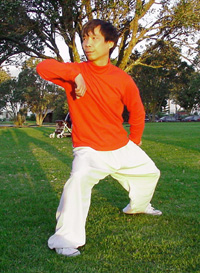 | |
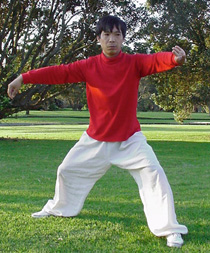 |
Master
Feng at the Temple of Heaven Park. |
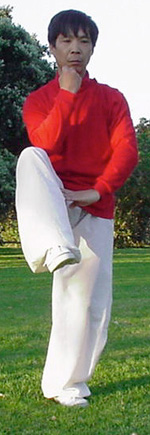 |
When practicing the form one must learn to relax naturally. The body must stay straight and in good balance. After that the upper and lower body can link together. One must pay close attention to the footwork. Good rooting must be built up so that one can then build the internal chi. The student must learn about the multidimensional circle. The whole body is a complex gear to produce a circle that is infinite. This requires true relaxation. Finally you must be quiet and peaceful. This is so you can feel the chi and body work together. Ph. 021-2568-442 or 444-3340 Auckland, New Zealand | |
Chen Fa Ke

Perhaps the best known taijiquan master of the Chen system this
century is Chen Fa-Ke![]() .
His high level of skill has been recounted by many who knew him well. He is
remembered for his dilegent practice, performing at least 30 sets of boxing
a day, as well as 300 repetitions of "pole shaking" exercises.
.
His high level of skill has been recounted by many who knew him well. He is
remembered for his dilegent practice, performing at least 30 sets of boxing
a day, as well as 300 repetitions of "pole shaking" exercises.
In 1928 he travelled to Beijing at the request of Chen Zhao-Pei, his nephew.
He established a name for himself, defeating a number of noted martial artists.
As a result of this, Chen family Taijiquan became well known.
As a growing number of people came to learn taijiquan out of admiration for him, Chen Fa-Ke, at his students urging, set up the Zhongzhou Wushu Centre in Beijing's Xuanwumen District. Among the applicants were even skilled wushu masters, including Liu Rui-Zhi, Tang Hao, Li Jing-Wu, Gu Liu-Xin and Feng Zhi-Qiang.
Chen Fa-Ke never had the chance to go to school, but he was an honest and tolerant person. His simplicity and uprightness won him great respect from his disciples. Although held in high esteem as a great taijiquan master, Chen Fa-Ke never belittled other schools.
When his disciples asked him what kind of wushu was the best, his invariable answer was that all schools, taijiquan included, are good so long as they have survived the tests of time; otherwise they would have long been eliminated.
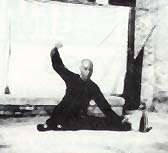
He believed that whether a school of wushu is good or bad depends to a large extent on the way of teaching and learning. At the beginning, it is the teacher who has the primary role to play and a good teacher should have a good knowledge of what he is teaching and he should be able to point out the correct way to learn for his students. As for who will learn faster, it all depends on the learners themselves.
Chen's words have been taken by his followers as a maxim that one should always be modest and draw on the strong points of different schools. Before he breathed his last, Chen Fa-Ke exhorted his son Chen Zhao-Kui and Feng Zhi-Qiang to practise wushu diligently and learn the strong points of other styles of wushu with an open mind so as to continually enrich the Chen-style taijiquan. It remains a great regret today that many of his wushu theories and routines were not collated and published.
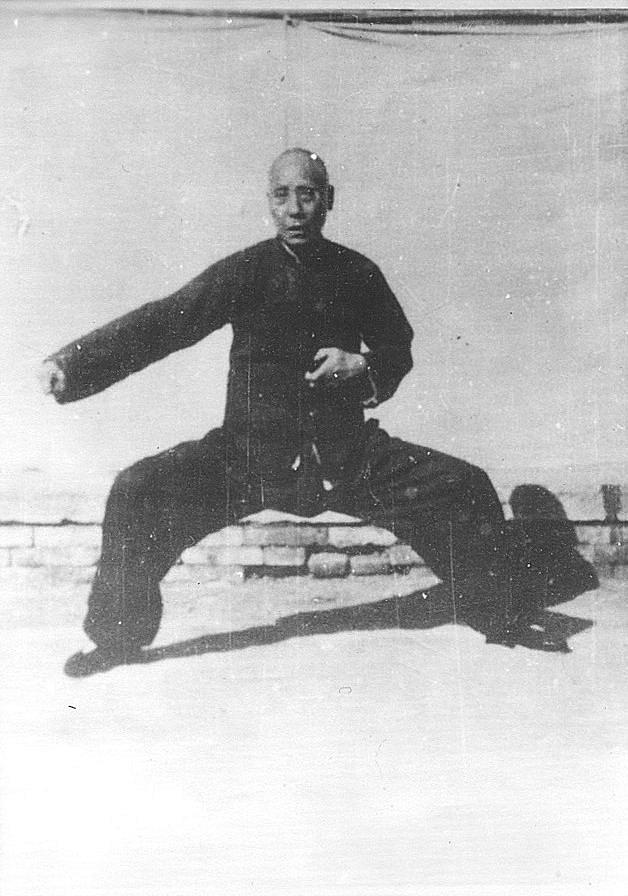
The name of Chen Fa-ke (1887-1957) is renowned in Taijiquan circles, particularly among the Chen stylists. One could ask ‘How truly proficient was Chen Fa-ke’s skill in Taijiquan?’ Some would reply they are unsure. Some would say he must have been very good as he was a famous Taijiquan master. As for querying how his skill compared with other Taijiquan masters of his generation, I believe few could answer this question.
This article is intended not only to reveal more about Chen Fa-ke as a famous master in the history of Taijiquan, but more importantly to provide a richer and more accurate picture of the heights attainable in Taijiquan as a martial art. Due to limited experience most people have a narrow view of the highest levels of Taijiquan. Their understanding is restricted to what their teachers have shown them and observing demonstrations by famous Taijiquan practitioners. They may believe they have seen the best in Taijiquan, whereas they have probably seen only a fraction of what is attainable. Once people become aware of the levels reached by Chen Fa-ke they are not as easily satisfied, but inspired to practice harder and pursue a greater degree of excellence.
Chen Fa-ke’s Family Background
Chen Fa-ke came from a long line of Taijiquan masters. His great grandfather Chen Chang-xing (1771-1853) was the teacher of Yang Lu-chan (1799-1872), the founder of Yang style Taijiquan. Only after studying for many years under Chen Chang-xing did Yang Lu-chan master the true martial art of Taijiquan. Chen Chang-xing’s father Chen Bing-wang was also very famous for his Taijiquan skill. Chen Chang-xing earned his living as a security guard transporting cargo through the Henan and Shandong provinces. He always made a safe delivery as the local bandits were intimidated by his martial prowess and left him alone. When Chen Chang-xing retired he opened a martial art school in his village.
Chen Geng-yun, the grandfather of Chen Fa-ke, lived to 79 years of age. From a young age Chen Geng-yun was trained in the martial arts by his father Chen Chang-xing. As an adult he also worked as a cargo transport guard. He once took part in a local battle and greatly contributed to its success. On one occasion he was delivering cargo to Lai-zhou town in Shandong province and defeated the notorious local bandit Tian Er-wang. The grateful townspeople donated money to erect a memorial in his honour. In the early 1900s a provincial government official Yuan Shi-kai, who later became the first president of the Chinese Republic, saw this memorial. Yuan Shi-kai was so impressed that he located the hero’s son Chen Yan-xi and brought him to train his sons for six years. Chen Yan-xi, the father of Chen Fa-ke, was a Taijiquan master in his own right and lived to the age of 81. He was also a famous master of traditional Chinese medicine.
The following story was related by Chen Fa-ke to his student Hong Jun-sheng (1907-1996). When Chen Yan-xi returned home after several years of teaching the sons of Yuan Shi-kai he was very pleased to see that Chen Fa-ke had made great progress in Taijiquan. Chen Yan-xi walked to the centre of the courtyard, inserting his hands in the opposite sleeves of his traditional leather coat. He asked his son and several nephews to surround and attack him. As soon as someone touched him he would turn slightly and the attacker would be propelled to the ground. Chen Fa-ke, relating this story to Hong Jun-sheng, sighed with feeling ‘I’m not as good as my father. When I strike someone I still need to use my hands’. This episode left a lasting impression on Chen Fa-ke and inspired him to greater achievement. Hong Jun-sheng once told me that Chen Fa-ke finally did reach this standard in the later years of his life.
Chen Fa-ke had told Hong Jun-sheng much about his early life and training in Taijiquan. Chen Fa-ke was born when his father was quite old, and was the only surviving son in the family as his brothers died in an epidemic. He was spoilt and lazy as a child. As a result of poor eating habits and lack of exercise, he was unfit and developed a lump in his abdomen which at times was so painful that he would writhe in his bed. Although he was aware that Taijiquan is beneficial to health, and would probably help reduce the pain and heal the lump, he had become so weak he avoided training. Due to his ill health he was excused from practising, and up to 14 years of age he still had not trained very much.
Chen Fa-ke had a cousin who was living with them while his father was away teaching the family of Yuan Shi-kai. The cousin kept Chen Fa-ke company, and assisted with farm work and looking after the family. He was a strong healthy young man of sturdy build, and he was one of the best of the young Taijiquan artists in the Chen village. One evening, during an after dinner conversation among the elders at Chen Fa-ke’s home, the subject was brought up about the traditional family martial art. Someone in the group sighed regretfully, saying ‘In Chen Yan-xi’s family lineage each generation has produced a highly skilled practitioner. It’s a pity to see this tradition end in Chen Fa-ke’s generation. He’s already 14 but he’s still so weak and fragile he cannot put in the necessary effort. It appears obvious that it will lost forever.’ When Chen Fa-ke heard this comment he felt ashamed, saying to himself ‘No matter what the cost I won’t allow our family traditional skills to be lost at my hands. At the least I can catch up with my cousin.’
He then realised, ‘We eat, sleep, work and train together. I may train hard to improve, but so will he. How can I ever catch up?’ This problem disturbed him, and for days he couldn’t eat or sleep. One morning he and his cousin were walking to work in the fields. Partway there his cousin stopped, suddenly recalling that he had forgotten a farming tool. He said to Chen Fa-ke, ‘You hurry and retrieve it for me. I’ll walk slowly till you catch up’. Chen Fa-ke quickly complied. During lunch time Chen Fa-ke reflected upon his cousin’s chance remark, and was inspired to relate it to his plans for training in the martial arts. He concluded that if he trained harder than his cousin he would make speedier progress and eventually catch up.
From then on Chen Fa-ke resolved to practice much harder, without making his cousin aware of his extra efforts. In addition to training with him, he continued to train at midday when his cousin napped. He shortened his sleeping time to just over two hours, and would get up and train some more. Since he was afraid to waken his cousin by the noise of going outside to practice, he trained in the small space between their beds. He modified noisy movements such as stamping the foot and developed a gentler and more relaxed form.
Chen Fa-ke thus trained extremely hard for three years till he was 17, with his cousin completely unaware. Occasionally, Chen Fa-ke practiced push hands with his uncles, but dared not train with his cousin whose skill was superior. His cousin took push-hands seriously and often injured his partners. He would remark, ‘Martial art training should be taken seriously. You cannot take it lightly just because you’re training with someone you know. Once taking it lightly becomes a habit you will be disadvantaged when facing the enemy’. Even when training with family the cousin would not relent the tiniest amount, often throwing his opponents so hard they would injure themselves and bleed.
After training hard for three years Chen Fa-ke found that the lump in his belly had virtually disappeared and his fitness had improved. His health and strength had become normal for a boy of his age. Meanwhile his martial skills had progressed unnoticed. One day, in order to test how much progress he had made he invited his cousin to practice push hands. His cousin laughed and said, ‘Well, all but one of the young men of our family have experienced my skill. Previously you were too delicate and dared not push hands with me. Now that you have become stronger and sturdier, you should be able to withstand my strikes and throws. It is now time for you to get a taste of my push hands skill’.
Following this conversation they took position. His cousin tried three times to advance and throw Chen Fa-ke using fajin. On each occasion he was instead countered and thrown back by Chen Fa-ke. Not until the third time did his cousin suspect that Chen Fa-ke’s skill had surpassed his own, yet he wasn’t fully convinced. He was upset at losing, and as he was leaving he grumbled, ‘Every generation in your lineage produces masterhand practitioners, probably by passing down secret techniques. Even hopeless ones like you who are not as good me can now defeat me. There is no point for any of my lineage to practice this art, for we don’t know the secrets’.
Chen Fa-ke informed Hong Jun-sheng, ‘In fact, my father had not been home those previous three years, so he could not have taught me any secret family techniques. My skill was purely the result of three years hard work’.
Through these incidents we can see the importance of hard training. Diligent and consistent practice is important to become stronger and make greater progress in our techniques. We cannot conclude from this story that there are no secrets in Taijiquan, but rather that secrets are relatively unimportant. It is true that for those three years his father could not have taught him any secrets. However, prior to this period Chen Fa-ke would have become aware of his father’s training methods and principles, he just had not put in the necessary effort to properly train them. Moreover, during the three years of his hard training he had also trained with his uncles, who would have reinforced the authentic principles of Taijiquan. To claim there are no secrets is simply to state that Chen Fa-ke did not know any principles or techniques unknown to his cousin. All martial artists in the Chen village were practising the traditional Chen style martial art. Chen Fa-ke had progressed quickly and achieved a great understanding of Taijiquan through his determination to work hard, firstly by spending more time, and secondly by training with feeling. In contrast, once his cousin had achieved a certain level of skill he was satisfied with his ability. Unlike Chen Fa-ke he didn’t train as much nor did he truly put his heart into it, thus he was eventually surpassed by him. For the normal Taijiquan practitioner like one of us it is certainly not sufficient to train hard. It is first essential to learn the correct techniques, following with hard training will lead us to success. My Chen style teacher Hong Jun-sheng always said, ‘We have to train Taijiquan the smart way. We need to use our brain. First we learn to train correctly, then we put in the hard effort’.
The Martial Art Exploits of Chen Fa-ke
Many sensational combat tales have been passed down to us about Chen Fa-ke. These stories could provide material for many excellent and exciting movies and television series. Yet, if we talk about something fanciful it may prove fascinating but we cannot learn much about real Taijiquan. We need to ascertain the truth about Chen Fa-ke to stimulate interest and lead students to pursue the true principles of Taijiquan. Also, if we try to emulate fictitious exploits we may lose confidence in our art and give it up from a falsely perceived inadequacy on our part. Only if we can discern which of the stories are true can we be inspired to train hard in the right direction.
I will therefore introduce some stories about Chen Fa-ke which are not just fables. I have selected each story according to three sets of criteria to ensure a high degree of credibility.
1. The story has been passed down by a direct student of Chen Fa-ke or by a family member. This person must either have witnessed the events in person, or have had them directly related by Chen Fa-ke. Also, the person must be deemed a reliable and trustworthy source.
2. The martial art techniques depicted must all be consistent with the principles of Taijiquan. We can thus explain how they work and be able to learn from them.
3. The martial art skills demonstrated in the story are those we deem Chen Fa-ke must have possessed, because many different people have purportedly witnessed him using these same skills in different situations.
For each story I mention I will provide some explanation, to allow readers to decide for themselves if the story is believable. I will first mention a story in the next section which has been reported in many books and newspapers. By analysing this story I wish to show that it cannot relate to true events. In 1928 Chen Fa-ke’s nephew Chen Zhao-pi was teaching in Beijing. Many people came to challenge him and test his skill in Taijiquan. Among these challengers were the powerful and famous ‘Three Heroic Li Brothers’ who were keen to try him. Chen Zhao-pi was worried he would lose against them and sully the reputation of the Chen family. He quickly sent for his uncle Chen Fa-ke to defend their family honour. When Chen Fa-ke arrived in Beijing he was taken to meet the brothers. It was a summer evening and all three brothers were at home. Chen Fa-ke was left waiting in the courtyard while Chen Zhao-pi went inside to speak to them. The eldest brother sat in an armchair drinking tea. Chen Zhao-pi suffered great fright and broke into a sweat when he saw the opponent, who looked tall and strong. He thought, ‘Uncle had better win this fight, for if he comes to harm I will be in deep trouble with the family’. When the Li brother saw Chen Zhao-pi hesitating he demanded, ‘Do you come willing?’ Chen Zhao-pi replied, ‘Don’t you want to see the Chen family martial art?’ Li shouted in response, ‘Well!’ slamming down on the table and propelling the tea bowls and pot into the air. Li moved away from his armchair and stood waiting like an iron tower. At this point Chen Fa-ke dashed into the house. As Chen Zhao-pi was trying to move away, he heard his uncle shout ‘Hah!’, the sound he made when exerting internal power. The next he knew the ‘iron tower’ was violently thrust away and thrown against the window sill, breaking the window. The other two Li brothers just stood in shock. As Chen Fa-ke was preparing to leave he asked, ‘Who want to try again ?’ The Li brothers slunk away like cats.
This tale of Chen Fa-ke seems to be very facinating. One day
when I was chatting with Master Hong Jun-sheng he told me it is just a fable.
Master Hong was a practical person, yet he had no doubts about Chen Fa-ke’s
skill and abilities. He believed it is sufficient for us to learn from Chen
Fa-ke’s example of self-discipline in training, without recourse to fantastic
stories. According to Master Hong there are several unreliable aspects to
the above story. Firstly, Chen Fa-ke was invited to Beijing by Chen Zhao-pi
for totally different reasons (more on this later). Secondly, Hong and other
students of Chen Fa-ke had never heard of this story. Thirdly, there is no
record of any persons called ‘The Three Heroic Brothers’ in Beijing
during that time. Finally, Chen Fa-ke was a friendly person, he did not behave
like a rogue and get involved in street-fights. Hong was a very practical
person. He did not like others to make up the story about Chen. Hong felt
the decent Chen Fa-ke was good enough for us to model and there is no need
to add on other unreal stories
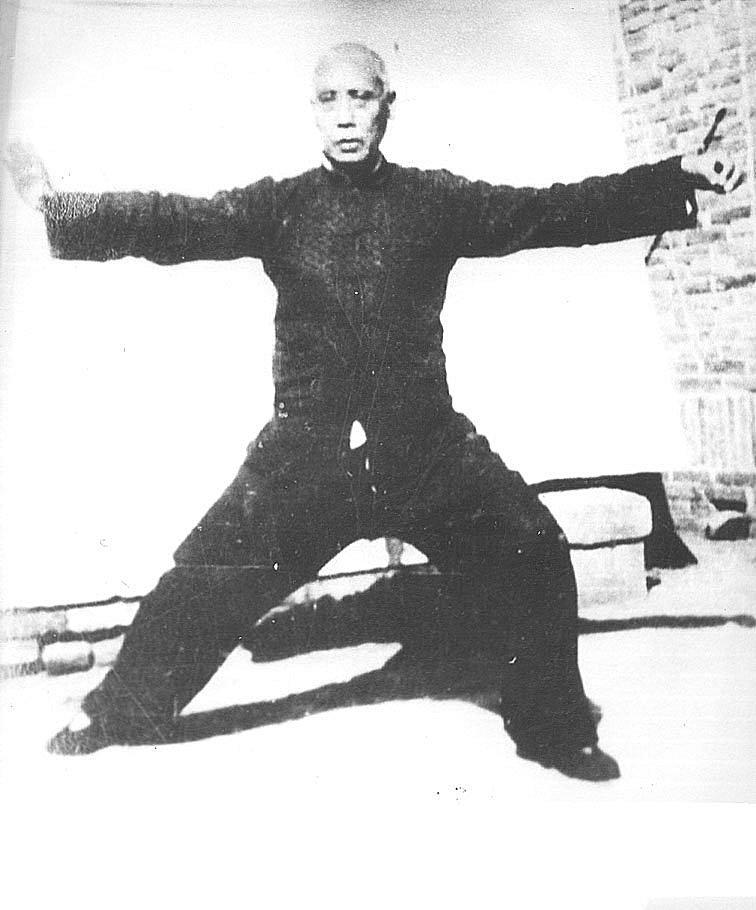
Feng Zhi-Qiang
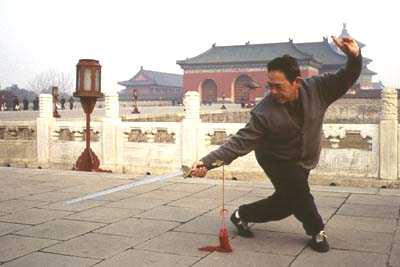
Master Feng poses in Temple of Heaven park.
Image captured by his student
Yau-Sun Tong
Among the many Chen-style followers, Feng Zhi-Qiang of Beijing stands out as a prominent master of great skill. Born in 1926, Master Feng Zhi-Qiang is now in his early 70's. Master Feng, a member of the Chinese Wushu Association is the Vice President of Beijing Municipal Arts Association, President of Beijing Municipal Chen-style Taijiquan Research Institute and head of Huaxia Martial Arts Club.
Master Feng's great-grandfather was a well known wushu master, and growing
up in such a family, Feng took to wushu in his boyhood. Master Feng began
to practice martial arts at eight, he learned a great variety of wushu forms
such as Shaolin stake exercises (Tongzi), tongbeiquan, (a kind of boxing imitative
of the movements of the ape's back), xingyiquan, and baguazhang from several
famous masters before taking up Chen-style taijiquan under the guidance of
Chen Fa-Ke, grandson of Chen ChangXing. With over 50 years of martial arts
practice behind him, he commands an excellent knowledge of all the northern
schools of wushu (kungfu) and is especially well versed in the Chen-style
taijiquan.
On his Xingyiquan teacher's (Master Hu Yaozhen) recommendation, Feng began to learn the Chen-style taijiquan from Chen Fa-Ke in Beijing. Besides Feng, Chen Fa-Ke had about a dozen other pupils. Every morning and evening, they practised in Chen's house under the watchful eyes of their master. Eager to learn and diligent in practice, Feng ZhiQiang was regarded as a promising student by Chen who had a high opinion of him.
Feng developed a high level of proficiency in Chen-style taiji
push-hands (tuishou) as a result of his diligence and determination to engage
the master daily, and being repeatedly thrown to the ground. Through intensive
training with Chen Fa-Ke, Feng mastered the grappling, throwing, and shaking-strength
skills of Chen-style Taijiquan
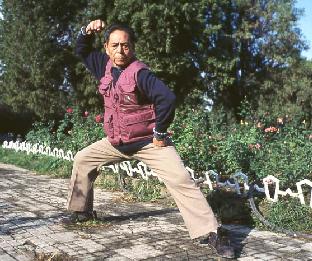
Master Feng at the Temple of Heaven Park.
Image captured by Yau-Sun
Tong
Chen Tai Chi: First Routine
This style of Chen Tai Chi was first taught in public by Chen Fa
Ke(17th generation of Chen Tai Chi). It has actions such as winding the wrists
and shoulders, folding the waist and chest, springing and leaping, and emphasizing
Chan Ssu Jing, which makes it appears more dynamic and explosive than any other
styles of Tai Chi.
The First Routine consists of 83 postures. The forms are
strongly accented with various qinna techniques.
Chen Tai Chi: First Routine
1.
Preparing Form
2. Buddha's Warrior Attendant Pounds Mortar
3. Lazily Tying
Coat
4. Six Sealing and Four Closing
5. Single Whip
6. Buddha's Warrior
Attendant Pounds Mortar
7. White Crane Spreads Wings
8. Walking Obliquely
with Twist Step on Both Sides
9. First Closing
10. Wade Forward with Twist
Step on Both Sides
11. Walking Obliquely with Twist Step on Both Sides
12. Second Closing
13. Wade Forward with Twist Step on Both Sides
14.
Hidden Thrust Punch
15. Buddha's Warrior Attendant Pounds Mortar
16.
Draping Over Body
17. Lean with Back
18. Blue Dragon Out of Water
19. Push Both Hands
20. Change Palms Three Times
21. Punch at Elbow's
Bottom
22. Step Back and Whirl Arms on both Sides
23. Step Back and Press
Elbow
24. Middle Winding
25. White Crane Spreads Wings
26. Wade Forward
with Twist Step on Both Sides
27. Flash the Back
28. Hidden Thrust Punch
29. Six Sealing and Four Closing
30. Single Whip
31. Wave Hands
32. High Pat on Horse
33. Rub with Right Foot
34. Rub with Left Foot
35. Kick with Left Heel
36. Wade Forward with Twist Step on Both Sides
37. Punch the Ground
38. Turn Over Body and Double Raise Foot
39. Beast's
Head Pose
40. Tornado Foot
41. Kick with Right Heel
42. Hidden Thrust
Punch
43. Small Catching and Hitting
44. Cover Head and Push Mountain
45. Change Palms Three Times
46. Six Sealing and Four Closing
47. Single
Whip
48. Forward Trick
49. Backward Trick
50. Part Wild Horse's Mane
on Both Sides
51. Six Sealing and Four Closing
52. Single Whip
53.
Shake Both Feet
54. Jade Girl Works at Shuttles
55. Lazily Tying Coat
56. Six Sealing and Four Closing
57. Single Whip
58. Wave Hands
59. Shake Foot and Stretch Down
60. Stand on One Leg on Both Sides
61.
Step Back and Whirl Arms On Both Sides
62. Middle Winding
63. Step Back
and Press Elbow
64. White Crane Spreads Wings
65. Walking Obliquely with
Twist Step on Both Sides
66. Flash the Back
67. Hidden Thrust Punch
68. Six Sealing and Four Closing
69. Single Whip
70. Wave Hands
71.
High Pat on horse
72. Cross Waving Lotus
73. Punch the Crotch
74.
White ape Presents Fruit
75. Six Sealing and Four Closing
76. Single Whip
77. Dragon on the Ground
78. Step Forward with Seven Stars
79. Step Back
and Mount Tiger
80. Turn body and Wave Double Lotus
81. Cannon right Overhead
82. Buddha's Warrior Attendant Pounds Mortar
83. Closing Form
The Second Routine
The Second Routine consists of 71 postures. In contrast to the first routine, the movements of the second routine, also known as paochui ("cannon fist") are predominantly "hard".
Chen Tai Chi: Second Routine (Cannon Fist)
1. Preparatory Form
2. Buddha's Warrior
Attendant Pounds Mortar
3.Lazily Tying Coat
4. Six Sealing and Four
Closing
5. Single Whip
6. Move and Hinder with Elbow
7. Protecting
Heart
8. Twist Step on Both Sides and Walk Obliquely (Jin Bu Xie Xing)
9 . Sink Waist with Elbow Down
10. Go Straight with Left Palm into Well
11. Plum Blossoms Scattered by Wind
12. Buddha's Warrior Attendant Pounds
Mortar
13. Protecting the Body
14. Putting Fists Aside Before Body
15 Cut Hand
16. Turn Flowers Out and Brandish Sleeves
17. Covering Hand
and Arm
18. Jump a Step and Twist Elbow
19. Wave Hands
20. High Pat
on Horse
21. Wave Hands
22. High Pat on Horse
23. Cannons in Series
24. Cannons in Series
25. Cannons in Series
26. Ride Animal in Reverse
Direction
27. White Snake Spits Tongue
28. White Snake Spits Tongue
29. White Snake Spits Tongue
30. Turn Flowers Out from Bottom of the Sea
31. Covering Hand and Arm
32. Turn body with Six Closing
33. Wrap Crackers
34. Wrap Crackers
35. Wrap Crackers
36. Wrap Crackers
37. Beasts Head
Pose
38. Splitting Pose
39. Turn Flowers Out and Brandish Sleeves
40. Covering Hand and Arm
41. Tame the Tiger
42. Hitting Eyebrow Makes
Red
43. Yellow Dragon Stirs Water Three Times
44. Yellow Dragon Stirs
Water Three Times
45. Kick with Left Heel
46. Kick with Right Heel
47. Turn Flowers Out from Bottom of the Sea
48. Covering Hand and Arm
49. Sweeping Leg
50. Covering Hand and Arm
51. Dash Leftward
52. Dash
Rightward
53. Thrust Reversely
54. Turn Flowers Out From Bottom of the
Sea
55. Covering Hand and Arm
56. Attack Twice with Forearm
57. Attack
Twice with Forearm
58. Linking Cannons
59. Jade Girl Works Shuttles
60. Cannon of Turning Head
61. Jade Girl Works Shuttles
62. Cannon of
Turning Head
63. Putting Fists Aside Before Body
64. Twist Elbow
65.
Smooth Elbows
66. Elbow of hitting Heart
67. Cannon Out of Bosom
68.
Go Straight with Left Palm into Well
69. Plum Blossoms Scattered by the Wind
70. Buddha's Warrior Attendant Pounds Mortar
71. Closing Form
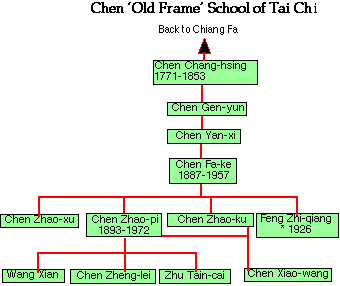
There are two principal traditions of Tai Chi in the Chen Family. In both cases the traditions were a combination of the Tai Chi that was taught to the Chen Family by Chiang Fa with the traditional Chen Family Cannon Pounding (Pao Chui) art which had derived from the Shaolin Temple tradition.
One school of Tai Chi, the so-called Old Frame of Chen Tai Chi developed from Chen Chiang-hsing (who taught Yang Lu-chan) and his student, Chen Gen-yun. His student Chen Yan-xi taught Chen Fa-ke (1887- 1957, the foremost exponent of this style whose students are responsible for its spread.
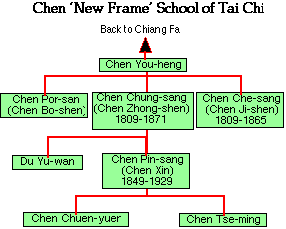
The New Frame of Chen Tai Chi developed from Chen You-heng, another student of Chiang Fa and developed via Chen Chung-sang to Chen Xin [a.k.a Chen Pin-sang] (1849-1929), the foremost latter- day exponent of this style .
The Old Frame Chen Style of Tai Chi bears a close resemblance to the New Frame Chen Style and also to the Zhao Bao and Hu Lei styles. Apparently it is not based on the classic '13 postures' which are central to the Yang and Wu Styles of Tai Chi and so it varies considerably from them.
The Development Of Chen TaijiquanThe Chen Family Cannon Pounding Art (Pao Chui)
The Chen family assimilated all the arts they practiced and created their
own version of the predominant art which they practiced, Cannnon Pounding
(Pao Chui), derived from the original Shaolin Cannon Pounding art. Sung Tai
Zhu Chang Chuan formed a major part of this new art and there were elements
from Shaolin Red Fist in it.
What resulted is five routines of Chen family Pao Chui and one routine of
`Short Hitting' (duan da) and the song formula stated a total of a 108 postures
consisting the art. There is much confusion over this particular song formula
but on closer examination the correct name should be 'Boxing Canon Complete
Formula' and is only found in the later Liang Yi Tang Ben manual. By the time
the Wen Xiu Tang Ben Chen family martial arts manual was written it was noted
that the `second and third routines are lost'. The Wen Xiu Tang Ben makes
no reference to an art called Taijiquan or '13 postures' or 13 anything for
that matter. So it is an early reference to the state of the Chen family arts
before the advent of the Taijiquan of the Chen family that we know today.
The Chen family was famous for the Cannon Pounding art for several generations
and gained the beautiful name of `Cannon Pounding Chen Family' (Pao Chui Chen
Jia) in the region around the Chen village.
The Simplification Of Chen Routines
Somewhere along the line the Chen Pao Chui art was simplified to just two
routines. We have no evidence to indicated who was the one responsible for
this simplification. The furthest that we can trace it back is to Chen Chang
Xin, Yang Lu Chan's teacher. But even the Chen family geneology book does
not indicate that he was responsible for this momentous change, only indicating
that he was a boxing teacher with a nickname `Ancestral Tablet'.
We know for certain that two of the routines were already lost by that time
and so only the 3 remaining could account for the final two routines. Whether
there was an integration or that another routine was lost through time resulting
in the final two is not certain at all.
The Advent Of Internal Boxing In The Chen Arts
When did the Chen arts become a form of internal boxing as opposed to to their
parental arts which were external boxing?
Most of the Taijiquan lineages regard Jiang Fa as the one providing the input
that transformed the art from the external Cannon Pounding to the softer internal
art. Some have also credited his input as the reason why the transformed art
was called Taijiquan, a name reflecting a Taoist origin and also the classification
of the art as an internal one. The name, however, was not widely used for
the art until Yang Lu Chan popularised it in the capital city of Beijing.
From the early writings, we know that the form was originally called the '13
postures' and by that time the name Taijiquan was already in use as evidenced
by the Taijiquan Classic of Wang Tsung Yueh and the Ten Important Discourses
Of Chen Chang Xin1.
The classification of martial arts into external and internal came about because
of the new method of combat devised by Chang San Feng, a Taoist which resided
in the Wu Dang Mountains. It stressed overcoming external techniques using
calmness and appropriate action and from external form this martial art often
looked weak in comparison with external styles but could defeat them easily.
Internal Boxing was passed down through the generations with noted practitioners
like Chang Sung Chi, Huang Zhen Nan, Huang Pai Jia, Gan Feng Chi and Wang
Tsung. Wu Dang Internal Boxing still exists at the place of its birth though
it has been diversified into many different styles in the course of the centuries.
But still present in its syllabus is a form called Wu Dang Taijiquan. This
bears only a little resemblance to the popular Taijiquan of today but has
common theories.
We know that the Chen family was famous for generations for their Pao Chui
art which was a Shaolin form. It was only after Chen Chang Xin that the art
was considered an internal one and specifically from the lineages stemming
from Yang Lu Chan the founder of the Yang style of Taijiquan.
According to Chen Xin, Chen Chang Xin learned part of his art from Jiang Fa.
Chen Chang Xin had been practicing his boxing when Jiang Fa who was passing
by saw him practicing and burst out laughing. Realising that he was observed
Jiang Fa hurried away but Chen Chang Xin caught up with him and angrily challenged
him as Jiang had slighted his Chen family art. Chen grabbed Jiang's shoulder
from behind, Jiang simply turne around and Chen was thrown out and lay on
the floor. Realising the superiority of Jiang's art Chen asked Jiang to be
his master. Jiang who ran a Toufu shop in Xian was passing through villiage
after visiting his mother in Honan. Jiang said that he would return after
three years to teach Chen and he indeed returned at the appointed time after
which Chen Chang Xin brought him home and learnt Taijiquan from him.
Chen Xin also said that because Chen Chang Xin had studied with Jiang Fa,
the Chen family did not permit him to teach the family art of Pao Chui. This
could very well explain why Chen Chang Xin held his classes in secret in the
dead of night in the back courtyard of his home where Yang Lu Chan spied upon
him.
Chen Xin also introduced to Wu Tu Nan another Taiji master from the Chen village
called Du Yu Wan (the source for a song formula attributed to Jiang Fa's teacher
from Shanxi which is probably Wang Tsung Yueh. This is found at the back of
Chen Xin's book). According to Du, his art came down from Jiang Fa who was
from Kaifeng in Honan and that his form and Yang Lu Chan's form was the same,
even bearing the same postural names like `Grasp Sparrow's Tail' and the same
sequence. Du told him that his Taijiquan was not a family transmitted art
but a teacher transmitted art. The previous generations of the art, that is
the founder of his lineage, were present when Jiang Fa was teaching Chen Chang
Xin and had also learnt the art from Jiang Fa. He then demonstrated his form
to Wu Tu Nan and the form was the same as the Yang style of Taijiquan.
According to Chen Xin, Chen Chang Xin was very stiff in the upper body and
was therefore nick named `Mr Ancestral Tablet'. When he was learning under
Jiang Fa, Jiang made Chen practice some loosening exercises to rid him of
his stiffness before teaching him Taijiquan. The rest of the Chen family continued
in their practice of Pao Chui for which they were famous for.
The input from Jiang Fa, who traced his lineage back to Chang San Feng, which
indicates that his art was Wu Dang Internal Boxing or at the very least derived
from it, would mark the change of Chen family art from an external one to
an internal one.
The earliest available literature on Taijiquan indicates that the art consisted
of only 13 postures, the 8 Gates and Five Steps. We know that the 8 gates
were 8 postures which represented 8 different types of Jing (refined strength).
The Five Steps were the five different directions of their application. These
were probably incorporated into the existing Pao Chui postures and the slow,
relaxed, continuous and smooth manner of performing the form, the very element
which made Internal Boxing look weak, was also incorporated. The result was
a long form which had all the elements of Internal Boxing, a modified Pao
Chui form which was a vehicle for Internal Boxing's theories and practices.
This would have been the art that was transmitted by Chen Chang Xin.
The Question Of The 13 Postures
The form was also known as the 13 postures since all the techniques within
derived from the basic 13. This has always been standard in the Taijiquan
Classics that have come down from the Wu Yu Xiang and Yang Lu Chan.
The Wen Xiu Tang Ben does not state the existance of the new form. The Liang
Yi Tang Ben, a later manual does record it but calls it the 13 sections instead.
Chen Xin's book recorded the Xin Jia of the Chen Style of Taijiquan. The material
he records is quite different from that which was gleaned from him from Wu
Tu Nan.
We need to first recognise that Chen Xin's book was published posthumously.
He had 3 other collaborators who published the book after his death. How much
of the book is attributable to him is a matter of uncertainty. The fact that
the book was only published four years after his death would indicate that
considerable editing could have taken place by his 3 collaborators.
The Yang related styles of Taijiquan all agree on the classication of the
basis of the art which is the 13 postures. The postures of Peng, Lu, Ji, An,
Tsai, Lieh, Chou, Kao, Gu, Pan, Jin, Tui and Ding. These are the postures
delinated and referred to in the accepted Classic writings. In Liang Yi Tang
Ben, the form is called not only the 13 postures but also 13 sections, a rather
different classication which is carried on into Chen Xin's book where the
entire form is taught as consisting of 13 sections, each section having sub-postures.
This other classication is ignored by Tang Hao and Gu Liu Xin in their writings.
The 13 postures actually consists of 8 basic postures and 5 movements. The
8 basic postures differ slightly in the early Chen style publications. The
Liang Yi Tang Ben records the first four as Peng, Ji, Lou, Na and Chen Xin's
book records them as Peng, Lu, Ji, Na. Chen Tze Ming's book has the same song
formula as in Chen Xin's book but here the first four are recorded as Peng,
Shu, Ji, Na. The full 8 postures are named in Chen Tze Ming's book as Peng,
Shu, Ji, Na, Tsai, Lieh, Chou, Kao. It must be noted that the earlier manual,
the Wen Xiu Tang Ben did not contain any boxing theory. It was only in the
later Liang Yi Tang Ben that Taijiquan was first mentioned in the Chen family
documents and that boxing theory was recorded.
Chen Taijiquan Today
The Lao Jia or Old Frame of Chen style Taijiquan was first promoted by Chen
Fa Ke in the early half of this century. The Xin Jia or New Frame, Zhao Bao
style and the Hu Lei style all retain close resemblance to each other in terms
of how the postures are done. The Yang style, however, varies quite greatly
from the other Chen related Taijiquan styles. Given that this was the style
first taught by Yang Lu Chan when he returned from the Chen villiage, it would
indicated that what he was taught may have differed from the standard Chen
syllabus.
However, due to the ecumenical efforts of the current generation of masters,
six major styles of Taijiquan are now officially recognised. They are the
Chen, Yang, Wu Yu Xiang, Wu Chien Chuan, Sun and Zhao Bao styles. The Hu Lei
style is also growing in popularity and may in time be considered a major
style.
The 5 greatest promoters of the art today are Feng Zhi Chiang, Wang Xi An,
Chen Zhen Lei and Chen Xiao Wang. Their efforts have spread the practice of
Chen Taijiquan throughout the world and continue to serve as inspirations
for those who practice it.
http://sunflower.singnet.com.sg/~limttk/index.htm
The Martial Arts Practiced In The Chen Villiage
The Sung Tai Zhu Quan Connection
Tang Hao was the first to theorise that Chen Wang Ting invented Taijiquan
by integrating 29 of the 32 postures of General Qi Ji Kwang. In chapter 3
we have already ascertained that Gu was wrong about the origins of Taijiquan,
here we will see how the 32 postures of General Qi fits into the picture as
a basis for the development of Chen Taijiquan.
General Qi was a general during the Ming dynasty who compiled a book on effective
war techniques called the "New Book Recording Effective Techniques"
(Ji Xiao Xin Shu). In it he had sections of strategy, weapons usage, unarmed
combat and other aspects of war. In the section on unarmed combat he recorded
the names of 16 extant empty hand martial arts and took note of what made
effective boxing. He also recorded 32 boxing postures. Gu was the first to
assume that these 32 postures were an amalgam of the most effective techniques
of the 16 listed fistic forms. For many decades, this was the accepted truth
because of his reputation as a Taijiquan historian. Unfortunately he was wrong.
Based on the above assumption, Gu had posited that Chen Wang Ting had developed
his Taijiquan from General Qi's form which supposedly consisted of the best
techniques from the 16 extent fistic arts during the Ming dynasty. An impressive
pedigree. With a closer examination of the postures and their listing we discover
something else.
In 1918, the Shanghai Da Shen Bookshop published a book called the `Boxing
Canon' (Quan Jing) which was at that time one of the more complete books on
the many aspects of boxing. Inside it was included drawings of the original
32 postures of Sung Tai Zhu Chang Quan (First Emperor Of Sung's Long Boxing).
Upon closer examination, it was discovered that these 32 postures were identical
(there were some variant readings where similar sounding words were used in
place of each other though without losing the meaning of the posture name)
with the 32 postures in General Qi's book. General Qi had listed the 32 postures
of Sung Tai Zhu Quan as the first in the list of the many fistic forms he
mentioned.
A parallel comparison of the drawings and names of the 32 postures shows that
they are in fact identical. A posture listing of both sets are as follows:
The 32 Postures 1n General Qi's Book
1) Lazily Arranging Clothes
2) Golden Chicken Stands On One Leg
3) Pat Horse
4) Bending Single Whip
5) Seven Star Fist
6) Repulse Riding Dragon
7) Sweep Leg And Empty Bait
8) Hill Fairy Stance (qiu liu shi)
9) Repulse Thrusting Attack
10) Ambush Stance
11) Casting Away Stance
12) Pick Up Elbow Stance
13) Speedy Step
14) Chin Na Stance (Grappling Stance)
15) Middle Four Level Stance
16) Subduing Tiger Stance
17) High Four Level Stance
18) Repulse Insertion Stance
19) Well Blocking Four Levels
20) Ghost Kick Foot
21) Pointing At Pubic Region
22) Animal Head Stance
23) Spirit Fist
24) Single Whip
25) Sparrow Dragon On The Ground
26) Rising Sun Stance
27) Goose Wings Fold Body
28) Riding Tiger Stance
29) Bend Pheonix Elbow
30) Cannon Overhead
31) Follow Pheonix Eblow
32) Flag And Drum Stance
Sung Tai Zhu Chang Chuan's 32 Postures
1) Lazily Arranging Stance
2) Golden Chicken Stands On One Leg
3) Control Horse Stance
4) Bending Whip
5) Seven Star Fist
6) Repulse Riding Dragon Stance
7) Sweeping Foot And Lightly Empty
8) Hill Flowing Stance (qiu liu shi)
9) Repulse Thrusting Stance
10) Ambush Stance
11) Pulling Frame Stance
12) Bracing Eblow Upwards Stance
13) Escaping Step
14) Chin Na Stance (Grappling Stance)
15) Middle Four Level Stance
16) Subduing Tiger Stance
17) High Four Level Stance
18) Repulse Catching Stance
19) Well Blocking Stance
20) Ghost Kicking Stance
21) Pointing To Pubic Region
22) Animal Head Stance
23) Spirit Fist
24) Single Whip
25) Sparrow Dragon Stance
26) Rising Sun Stance
27) Wild Goose Wing Stance
28) Riding Tiger Stance
29) Bend Pheonix Stand
30) Over Head Stance
31) Follow Pheonix Stance
32) Flag And Drum Stance
What does this mean to Taijiquan? Chen Zhi Ming was the member of the Chen
family who accompanied Tang Hao to the Chen village. He, like Gu and Tang
also wrote about his family's Taijiquan. Chen Zhi Ming work contains records
the following about Sung Tai Zhu Quan:
`Tai Zhu stances are the strongest, tumbling and diagonal moving, even ghosts
have to be busy to get out of the way' from the Liang Yi Tang Ben manual of
Chen martial arts.
`Seven star fist and hands take care of each other, Pat Horse Fist comes down
from Tai Zhu' from the Wen Xiu Tang Ben manual of Chen martial arts
From the above, which are the earliest sources of information about Chen family
martial arts, it is clear that it was Sung Tai Zhu Quan that formed the basis
of Taijiquan with 29 of its 32 postures adopted into the form, and did not
come from General Qi's work which has no mention in Chen literature. This
inaccurate hypothesis having been originated by Tang Hao.
Sung Tai Zhu Quan or Sung Tai Zhu Chang Quan as it was also known, comes from
the south of China and is a external hard boxing form. It is characterised
by powerful strikes and movements, body shaking, being structurally aligned,
postures flowing with coordinated footwork, being very firm and stable both
in standing and stepping and is effective in grappling (chin-na). All of which
are present in Chen Taijiquan today. Sung Tai Zhu Chang Quan was not the only
art practiced and ultimately integrated into their unique family boxing routines,
from Chen Zhi Ming's record of the Chen arts song formulas, we know that Shaolin
Red Fist was also practiced.
Shaolin Red Fist (Hong Chuan)
The Liang Yi Tang Ben records that the Chen Villiage practiced 'four small
sets of Red Fist'. The Red Fist boxing is a Shaolin form. Given the close
proximity between the Chen Villiage and the Shaolin Temple, it is not surprising
that this form of boxing would be practiced there. The Red Fist boxing is
also widely practiced in Shanxi where it is several different and but related
sets, Tai Zhu Quan being one of them. Stylistically, it stresses low postures,
soft use of muscles, using the mind instead of strength, speedy emission of
power, guarding the four directions, agility, using the Qi circularly, closing
into the opponent and using sticking and leaning.
Shaolin Cannon Fist (Pao Chuan) And Cannon Pounding (Pao Chui)
Shaolin Cannon Boxing consists of 3 sets, 2 sets of Small Cannon Fist and
one set of Big Cannon Pounding. All three stress offense, using strikes like
the pounding of cannons. Firm stances and powerful, explosive blows characterise
it. This set is still being practiced in the Shaolin Temple to this very day.
Postures in it that are similar to Chen Taijiquan include `Tornado Kick' (Xuen
Fung Jiao), and `Cannons In Series' (Lien Huan Pao). The San Huang Pao Chui
which is derived from the Shaolin art contains movements like `Dash Leftward'
(Zhuo Chong) and `Dash Rightward' (Yu Chong) in it and would indicate that
there is some relationship to the Pao Chui of the Chen family. The Chen family
was famous for several generations for their Pao Chui (Cannon Pounding) boxing
art and were known as the `Pao Chui Chen Family' (Pao Chui Chen Jia).
Wu Dang Transmission?
Since the art was popularised there has been a widely accepted tradition among
the non-Chen lineages that there was input from the Wu Dang arts into Taijiquan.
So much so that Taijiquan is considered by many noted practitioners as a Wu
Dang art.
The first to record Wu Dang's Internal Boxing at length was Huang Bai Jia
and later the art was transmitted to Kan Feng Chi. Fortunately, we still have
a record of Kan's art with us and it is still practiced. What has come down
to us is the art which he combined both the Shaolin and the Wu Dang schools
into a single art and he called it Hua Chuan (Flower Fist). If there is indeed
a connection between the two arts, there should be some similar postures other
than similar Taoist theories.
We do find similar postures but not similar to Chen Taijiquan but to Yang
Taijiquan and its derivatives. Postures like Hitting Ears With Both Fists
(Shuang Feng Kuan Er) complete with smashing the face onto the knee first,
Playing The Lute (Shou Hui Pi Pa) with its characteristic elbow break on retreating,
Cross Hands (Shi Zi Shou) with its cross hand block, Embrace Tiger And Carry
Back To Mountain (Bao Hu Kui Shan), etc., are present in Kan's form.
Other resemblance comes from the art of the other great Wudang Internal Boxing
master Chang Sung Chi. His art consisted mainly of the `4 stable 8 methods',
the 4 stable techniques denoting the four directions and the eight methods
are which are eight different combat techniques with myrid changes. These
methods have another interesting name of `Yin Yang Five Element Eight Triagram
Taiji Hands'. Chang Sung Chi's boxing theories include similar theorems and
practices like sinking the qi to Huang Ting (Dan Tien), hollowing the chest
and lifting the spine, listening to jing, using softness to neutralise an
attack.
The postures are similar to those found in Yang Taijiquan and one can see
the similarity in the two man sets in terms of technique. Indeed, even in
an early Ta Lu interaction is there complete with the wrist grab (T'sai),
arm lock/break (Lieh) and the attack to the face following it (Bi).
This would seem to bear out the Yang lineage's assertion that at least part
of the art taught to Yang by Chen Chang Xin had input from the Wu Dang lineage
related to Kan Feng Chi, Chang Sung Chi and Huang Pai Jia.
It is indeed strange for Yang Lu Chan to have admitted learning from Chen
Chang Xin and yet attribute at least part of the art as having come from outside
the Chen villiage arts unless there was some element of the truth in it. What
could be possibly gained from it unless he denied he studied from Chen Chang
Xin, a member of the Chen family of the Chen Villiage. We know that the Chen
family did study arts from outside their villiage, so input from the Wu Dang
Internal Boxing lineage should not be so strange. And it would be in line
with the song formula at the back of Chen Xin's book which attributes transmission
to Jiang Fa and Wang Tsung Yueh.
The Shaolin Pole Techniques
The Shaolin Temple is well known for its martial arts, in particular its fistic,
broadsword and pole arts. Of the weapon arts of the Shaolin School, probably
the most famous is its pole arts. It was the favoured weapon of the Shaolin
Monks and they seldom left the temple without it in hand.
The song formula from Chen Zhi Ming's book confirms that the pole techniques
of the Chen family originated from the Shaolin Temple. The 'Sitting Arhat
Pole Formula' has these lines: 'Old Temple is the Shaolin Temple, the halls
had 500 monks...if you want to know where this pole came from, Sitting Arhats
transmitted it at Shaolin.' Gu Liu Xin did a comparison between the Chen family
pole techniques and the Shaolin Temple Pole techniques and concluded that
they were indeed related, sharing the same theory, the same body, hand and
foot methods. This is not surprising since the Chen Villiage is quite close
to the Shaolin Temple.
The Yang Family 24 Flower Spear
The Yang family Flower Spear art was extent even in the Ming Dynasty and was
recorded in General Qi Ji Kwang's `Ji Xiao Xin Shu' and consisted of 24 postures.
We need to note here that this Yang family is no relation to Yang Lu Chan,
the founder of the Yang style of Taijiquan who was also famous for his spear
techniques. The song formula recorded by Chen Zhi Ming in his book indicates
that the original set of 24 techniques were practiced by the Chen family.
The '24 Spear Song Formula' has this line: 'If you ask this spear's name and
family: Yang family Flower Spear 24'. The spear used in this set is a relatively
long one and its main emphasis is on thrusting techniques.
Training with the Short Stick (Pang)
One of the methods of training of Chen Taijiquan is to make use of a short
stick or club held in both hands and using twisting motions to train in it.
A similar exercise can be found in Kan Feng Chi's training methods where the
same thing is done.
We also have this method of training coming down from the training methods
of Chang Sung Chi, the other great Wudang Internal Boxing master. This could
indicate that at least part of the training methods used by the Chen family
could have come from a Kan Feng Chi, Chang Sung Chi related lineage.
Hsing-I Quan Influence?
The `Three Three Boxing Manual' written by Chen Xin contains three out of
the ten thesis of Hsing-I Boxing as well as Taijiquan theories. This would
indicate that some time in the history of Chen martial arts, Hsing-I Boxing
was practiced. Whether the whole art was present is questionable since only
three of the thesis are present.
Wu Tu Nan's Interview With Chen Xin And His Meeting With Chen Fa Ke
Wu Tu Nan visited the Chen Villiage in 1917. There were few educated people
in the villiage at the time and he was directed to meet Chen Xin, this was
before Chen Xin's book was published. Chen Xin was very frank in his interview
with Wu Tu Nan and gave him an account of how Taijiquan came to the Chen Villiage
(see chapter 6 on Yang style historical development for details). He said
that both Taijiquan and the indigenous Chen family Pao Chui was practiced
in the villiage but that Taijiquan came down from Jiang Fa. He also introduced
Wu to Du Yu Wan who practiced Taijiquan and who said his art came down from
Jiang Fa who was of the Wudang lineage, Du's subsequent book on Taijiquan
in 1935 confirms this view and the authenticity and accuracy of Wu Tu Nan's
interview material.
Chen Xin had told Wu that he was writing a book on Taijiquan. Wu then asked
Chen Xin whether he practiced Taijiquan. Chen Xin replied that his father
had let his older brother learn martial arts but had made him get an education
instead so he did not know any martial arts. Wu then asked how he was going
to write a book on martial arts if he did not practice martial arts. Chen
replied that Taijiquan is based on the Book of Changes and that he felt that
as long as an art conformed to the Book of Changes it was Taijiquan. So he
intended to use the boxing postures of Pao Chui and relate them to the Book
of Changes and that his purpose of the book was to show how the Book of Changes
was related even to martial arts, it was not his intention of writing a martial
arts manual.
With this background information, Wu Tu Nan had asked Chen Fa Ke during a
meeting around 1950 whether his art was Taijiquan, given that the definition
of Taijiquan was that is was based on the 13 postures. Chen Fa Ke had replied
that his art was not based on the 13 postures and so was not Taijiquan. The
meeting was cordial and it was not confrontational.
CHEN STYLE
TAI CHI CLASSES
Monday: 6.30 - 7.30pm Grey Lynn Library hall
Begginers and Experienced
Short form + Pushing hands
Tuesday 8.00-9.00pm North shore
Begginers and Experienced
Short form + Pushing hands
Wednesday: 6;30 - 7:30pm Grey Lynn Library hall
Begginers and Experienced
Long form + Pushing hands
Thursday 6.00 - 7.00pm Grey Lynn Library hall
Begginers and Experienced
Long form + Pushing hands
Sundays in the park 9-30-12-?
Under the first tree on the left opposite the
university clock tower
Albert Park
Auckland
Push hands in the park
learners or experienced,
all styles welcome
come and meet people of like minds
Sundays in the park 9-30-12-?
Under the first tree on the left ![]() opposite the
opposite the
university clock tower
Albert Park
Auckland
Phone 444-33400
A/Hrs Ph. 021-2568-442 or 09 828980
Email :louiseshrubshall@yahoo.co.uk
Traditional Chinese Massage
Phone 444-33400
A/Hrs Ph. 021-2568-442